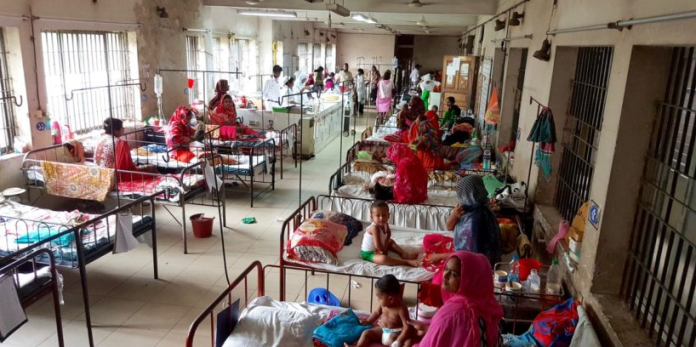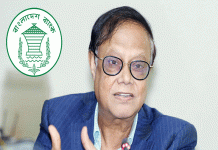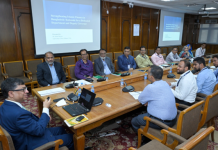
Kazi Nazifa Dilruba:
Bangladesh’s healthcare system stands at a historic crossroads, teetering between celebrated achievements and mounting systemic crises that threaten to unravel decades of progress. With a population exceeding 168 million—70% of whom reside in rural areas—the urgency to reimagine healthcare delivery, financing, and reform is greater than ever.
In recent decades, Bangladesh has received international recognition for improvements in key health indicators, such as a marked decrease in maternal mortality, widespread child immunization campaigns, and increased average life expectancy. These advances were hard-earned and emblematic of strong policy direction, community-based health initiatives, and donor support. Yet, these gains now face a serious challenge, as the healthcare system struggles to cope with an evolving disease burden and the growing expectations of a more informed and mobile population.
Non-communicable diseases (NCDs) such as heart disease, diabetes, and cancer are now the leading causes of death. However, the infrastructure and manpower needed to tackle these long-term illnesses remain woefully inadequate. Most hospitals lack specialists, critical diagnostic equipment, and essential supplies, particularly outside major urban centers like Dhaka and Chattogram. The healthcare disparity between rural and urban areas remains stark, leaving millions without timely or quality care.
Despite consistent economic growth and a projected nominal GDP of $467.2 billion by 2025, only 5.2% of the national budget is allocated to healthcare—far below the global average of 10.3%. This underinvestment has created a fragile ecosystem. Government hospitals are overcrowded, with long wait times and insufficient resources. Meanwhile, the private sector—though better equipped—faces criticism for being profit-driven, unaffordable, and lacking standardized practices. The result is a public health system that often fails to meet the needs of its citizens.
A visible and troubling outcome of this mistrust is the rising number of Bangladeshis seeking medical care abroad. According to 2023 statistics, nearly 450,000 Bangladeshis traveled to India for medical treatment—up sharply from 304,000 the year before. Kolkata remains a favored destination due to cultural familiarity and more reliable healthcare services. This medical exodus comes at a steep price: estimates suggest Bangladeshis spend more than $5 billion annually on foreign medical care—a massive outflow of national capital and an implicit indictment of domestic facilities.
• Just 5.2% of Bangladesh’s national budget goes to healthcare, less than half the global average (10.3%).
• Only 661 cardiologists serve 168 million people, with most specialists concentrated in Dhaka.
• 450,000 Bangladeshis sought treatment abroad in 2023, spending over $5 billion—equivalent to 1.5% of GDP.
• A 2023 investigation exposed 16 years of medical exam leaks, raising alarms about the quality of future doctors.
The reasons behind this trend are not difficult to identify. Bangladesh has only 661 registered cardiologists and 87 catheterization labs, most concentrated in Dhaka. Rural patients are left with limited options, often resorting to poorly equipped clinics or lengthy waits at government hospitals. Private hospitals, while more accessible in cities, often lack consistent diagnostic standards, creating a gap in reliable treatment outcomes.
Public trust in healthcare has also been severely undermined by recurring scandals and corruption. A 2023 investigation by Prothom Alo revealed that medical entrance exam questions had been leaked at least ten times over the past 16 years, casting serious doubts on the ethical and professional standards of the future medical workforce. Furthermore, numerous reports of misdiagnoses, malpractice, and negligence in both public and private institutions have contributed to widespread skepticism.
Meanwhile, regional models offer a glimpse of what Bangladesh could aspire to. India’s booming medical tourism sector, backed by clear policy frameworks, simplified visa systems, and international marketing, has made it a global hub for affordable and quality healthcare. Through institutions like the National Medical & Wellness Tourism Board, India has succeeded in attracting millions of patients from around the world. Ironically, despite its proximity and cultural similarities, Bangladesh has not yet managed to replicate this success.
Recent diplomatic tensions between Bangladesh and India have only intensified the crisis. Where once 5,000–7,000 medical visas were issued daily, current figures have dropped below 1,000. Thousands of patients are now left in limbo, unable to seek treatment abroad and with few domestic alternatives. While countries like Malaysia, China, and Singapore offer high-quality care, they remain financially out of reach for most Bangladeshi citizens, particularly the middle and lower-income groups.
This moment may serve as a critical wake-up call for Bangladesh to invest in a modern, self-sufficient healthcare system. Experts argue that solutions require more than just increased budget allocations. Deep structural reforms are essential. Proposals include overhauling medical education to introduce pre-medical programs and expand postgraduate training, especially in rural and underserved areas. There is also an urgent need to enforce ethical standards, eliminate examination leaks, and ensure malpractice is met with consequences.
Another major recommendation is the enforcement of continuous medical education (CME) for doctors, ensuring that practitioners stay updated with the latest advancements in medicine. Policymakers are also calling for partnerships with international hospitals, which could bring in foreign specialists to train Bangladeshi medical staff. One notable suggestion includes mandating that high-ranking public officials receive treatment within Bangladesh to rebuild public trust and set a national example.
Public-private partnerships (PPPs) are also being explored as a way to bring efficiency, investment, and innovation into the healthcare sector. By establishing world-class hospitals, diagnostic centers, and medical schools under strict regulatory supervision, Bangladesh can start reducing its dependence on foreign care and even emerge as a destination for regional medical tourism.
Uniform accreditation of diagnostic labs and healthcare facilities is another key component. Inconsistent lab results and varying standards have been a long-standing issue in both urban and rural setups. Projects like the China-Bangladesh Friendship General Hospital demonstrate that with proper planning and foreign collaboration, it is possible to raise the standard of care within the country.
If Bangladesh takes the right steps now, it could begin to attract patients not just from within, but from neighboring countries such as Nepal, Bhutan, and underserved areas of eastern India. Achieving this vision will require significant investment, especially in the development of specialized treatment centers and the pursuit of international accreditations such as those from the Joint Commission International (JCI). With aggressive promotion and commitment to affordability and quality, Bangladesh could realistically market itself as a cost-effective yet high-standard healthcare destination.
As the country prepares for the upcoming fiscal year, all eyes are on how the government will respond. The intersection of political will, financial allocation, and comprehensive reform will determine whether Bangladesh can ensure healthcare for its own citizens while laying the foundation to become a regional medical leader.
This transformation may be daunting, but it is essential—and within reach. Bangladesh’s future health, well-being, and economic stability may depend on the choices made in the months ahead.
DS..//







